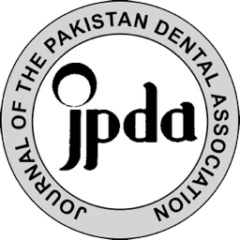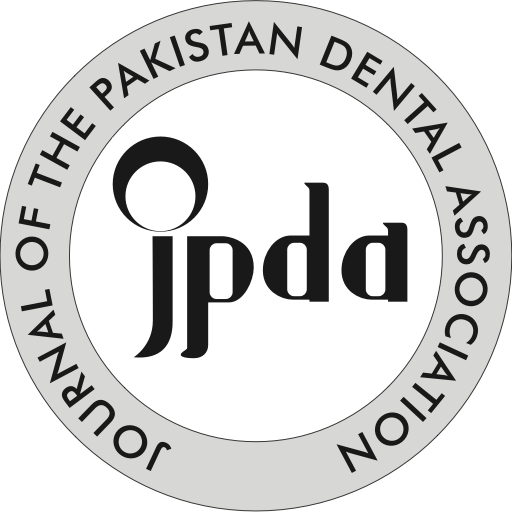
Muhammad Waseem Ullah Khan                BDS, FCPS
Sabiha Naeem                                 BDS
Qudsia Iqbal                                   BDS
Resection of maxilla creates oro-nasal communication which gravely compromises different functions like speech, swallowing, mastication and esthetics. Reconstruction of the maxillary defect generally require a multidisciplinary approach, but prosthodontic rehabilitation is the most practical, convenient and cost-effective mode of treatment along with the added advantage of oncological surveillance. This clinical technique describes a method of prosthodontic management of an Aramany’s class II type of maxillary defect with a definitive obturator prosthesis having a cast partial framework for a patient who underwent maxillary resection one year back as treatment for Pleomorphic adenoma.
KEYWORDS: Maxillectomy, Obturator, Prosthesis
HOW TO CITE: Khan MWU, Naeem S, Iqbal Q. Prosthetic rehabilitation of an acquired maxillary defect with definitive obturator prosthesis- A clinical technique. J Pak Dent Assoc 2020;29(2):100-102.
DOI: https://doi.org/10.25301/JPDA.292.100
Received: 09 August 2019, Accepted: 15 February 2020
INTRODUCTION
Maxillofacial defects result in facial disfigurement, impaired functions and have a great impact on patient’s quality of life. They face hyper-nasality, masticatory dysfunction & communication between oral and nasal cavities which leads to fluid leakage through nasal passage. These functional problems may lead the patient to emotional stress, anxiety, depression and social phobia.1,2,3
There lies a great dilemma either to rehabilitate the maxillary defects surgically or prosthodontically.4,5 The cardinal benefit of prosthodontic rehabilitation is to achieve oncological surveillance as it is easy to remove the obturator and examine the surgical site for detecting tumor recurrence. Prosthetic obturator is a simplified non-surgical approach
for the patient to rehabilitate the function of speech, deglutition, mastication, normal oro-facial appearance and it improves the quality of life.4-7 This clinical technique describes the prosthodontic management after the local excision of pleomorphic adenoma on the right side of the palate with the fabrication of a definitive palatal obturator.
CLINICAL TECHNIQUE
A 65-year-old male patient reported to the Prosthodontic department of Punjab Dental Hospital, Lahore, for the replacement of his interim obturator. The patient’s medical history revealed that he was type II diabetic and hypertensive. The patient had under gone local excision (Aramany’s class II type of palatal resection on the right side), one year back for the treatment of pleomorphic adenoma (Fig.1). Rehabilitation of the defect with obturator as a hollow bulb, having cast metal framework was decided. Designing
 Fig 1: Intra oral view
Fig 1: Intra oral view
 Fig 2: Design pattern drawn for lab instructions
Fig 2: Design pattern drawn for lab instructions
of the definitive prosthesis was finalized as shown in fig: 2. Major connector was extended up to the palatal surfaces of remaining present natural teeth to achieve the effect of bracing/stabilization. Additional support was added through full palatal coverage. Primary impressions were made with irreversible hydrocolloid. After planning on the surveyed cast mouth preparations were completed. Final impressions were made by two-step technique in which rubber based polyvinyl siloxane putty was used having wash impression of polyvinyl siloxane light body impression material on it.

Fig 3: Master cast
 Fig 4: Maxillary obturator inserted
Fig 4: Maxillary obturator inserted
Impressions were poured in type-IV model stone. The subsequent laboratory steps were performed as per standard protocol. Metal framework try-in was done in patient’s mouth
 Fig 5: Front occlusal view
Fig 5: Front occlusal view
and the bite was registered in the same appointment. Using jaw-relation record master-casts were mounted on semiadjustable articulator with arbitrary method. The try-in of the prosthesis was done after teeth setup. After flasking and dewaxing, curing of the prosthesis was done with heat cure acrylic in two steps. Roof of the defect was cured with the part of prosthesis containing teeth and size of bulb was approximated by adapting the modelling wax as a lid over of cast. This lid of modelling wax was cured separately with heat cure acrylic resin. Heat cured acrylic lid was attached to the roof of the defect with autopolymerising resin and a hollow bulb obturator was fabricated.
Finishing and polishing of obturator was done. Definitive obturator was inserted in patient’s mouth. Post-insertion
instructions were given and follow up appointments were scheduled for the patient. In follow-up appointments, patient was comfortable and satisfied with mastication, deglutition, esthetics and phonetics of the obturator. No complications were reported by the patient. Obturator can be made light weight by incorporating a hollow bulb in it which was done in this case. As obturator maintains its intimate contact superiorly and laterally with the soft tissue, its degree of movement is decreased.8 Hollow bulb obturator prevents the overburden on the remaining structures and provide structural durability and prevents resonance to speech.9,10
CONFLICT OF INTEREST
None declared
REFERENCES
- Singh M, Bhushan A, Kumar N, Chand S. Obturator prostheses for hemi-maxillectomy patients. Natl J Maxillofac Surg 2013;4:117-20. https://doi.org/10.4103/0975-5950.117814
- Jaykumar, kandarphale M.B, Anand V, Mohan J, Kalaignan P. Definitive obturator for maxillary defect J Integ Dent 2017;21-4.
- Khan MW, Shah AA, Fatima A. Single-Step Fabrication of a New Maxillary Obturator Prosthesis. J Dent Oral Disord Ther 2015;3:1-4. https://doi.org/10.15226/jdodt.2015.00136
- Chen C, Ren W, Gao L, Cheng Z, Zhang L, Li S, Zhi PK. Function of obturator prosthesis after Maxillectomy and prosthetic obturator rehabilitation. Braz J otorhinolaryngol 2016;8:177-83. https://doi.org/10.1016/j.bjorl.2015.10.006
- Kreeft AM, Krap M, Wismeijer D, Speksnijder CM, Smeele LE, Bosch SD, Muijen MS, Balm AJ. Oral function
after maxillectomy and reconstruction with an obturator. Int J Oral Maxillofac Surg 2012;41;1387-392. https://doi.org/10.1016/j.ijom.2012.07.014 - Khan MW, Shah AA, Fatima AL, Hanif A. Subjective assessment of obturator functioning in patients with hemimaxillectomy. Pak J Med Health Sci 2014;8:694-97.
- Srivastava N, Goyal P. Palatal obturator: An update EC Dent Sci 2017;9:124-27.
- Naveen YG, Sethuraman R, Prajapati P. Definitive maxillary obturator prosthesis. Int J Prosthet Dent 2011;2:22-6
- Fernandez T, Rodrigues SV, Vijaynand KR. A titanium cast hollow definitive obturator prosthesis for a maxillary patient. Int J Prosthodont Rest Dent 2016;6:69-72. https://doi.org/10.5005/jp-journals-10019-1159
- Srivastava N. A two-piece sectional definitive obturator: a clinical report. J Dent Heath Oral Disord Ther 2016;4:00132. https://doi.org/10.15406/jdhodt.2016.04.00132
- Assistant Professor, Department of Prosthodontics, deMontmorency College of Dentistry Punjab Dental Hospital, Lahore.
- FCPS Resident, Department of Prosthodontics, deMontmorency College of Dentistry Punjab Dental Hospital, Lahore.
- FCPS Resident, Department of Prosthodontics, deMontmorency College of Dentistry Punjab Dental Hospital, Lahore.
Corresponding author: “Dr. Sabiha Naeem†< cute_sabi85@yahoo.com >


